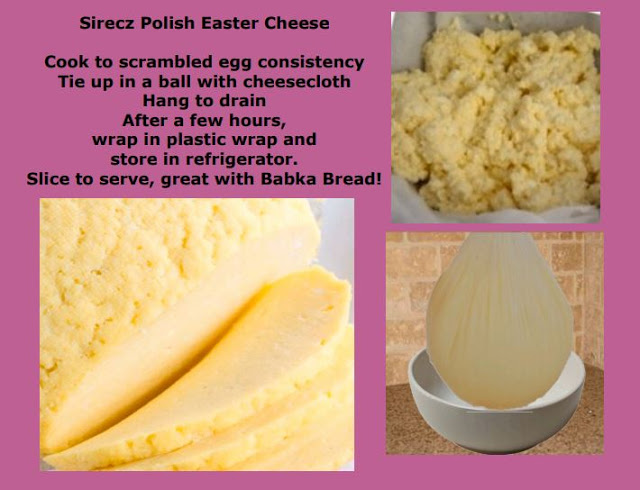Today I am making the traditional butter lamb for our Easter Dinner.
I make the lambs and often gift them to friends and family. In some areas you can find them in grocery stores ready made but if not, they are really easy to make. The easiest way is to simply use a mold. You can find them on line,at Polish specialty shops and sometimes religious goods stores. They come in inexpensive plastic or higher end wood molds. If you don't have a mold, you can form a simply lamb shape using a stick of butter as the base, hand form the head and use grated butter shreds to mimic the curly wool.
The molds are reusable and last for many years.
You simply use room temperature butter. Start with a small amount and be sure to press and force the butter into the fine details then fill the rest of the mold. Clean up the edges so removal will be easy and put the two parts together pressing well. Place in the refrigerator over night. You can freeze it as well. Once completed firm remove the lamb from the mold and decorate with a traditional red ribbon and a resurrection flag.
I hope you will add the butter lamb to your family's Easter celebration.
You can find detailed information about our Polish Easter feast on my blog post here: Soapsmith's Polish Easter
Other Classic Polish Easter Dishes:
Keilbasa
Cwikla - Red Beets with Horseradish
3 cups cooked or canned beets, drained and grated
4 oz. finely grated fresh or prepared horseradish
1 Tbsp. sugar
1/4 cup vinegar
1/2 tsp. salt
Combine all of the ingredients, cover and refrigerate for two days. You can alter this to your taste by adjusting the measurements.
Easter Babka
1-1/4 cups lukewarm milk
2 packages active dry yeast
6 tablespoons sugar
6 to 6 1/2 cups all-purpose flour
1/2 teaspoon salt
10 egg yolks
3/4 lb plus 2 tablespoons unsalted butter, softened
1 cup white seedless raisins, cherries, or apricots
2 tablespoons chopped candied orange peel
1 tablespoon lemon zest
Dissolve yeast in the lukewarm milk and add 1/2 teaspoon of the sugar. Let the mixture stand for 2 or 3 minutes, then stir to dissolve the yeast completely.
Place the 6 cups of flour and the remaining sugar and the salt in a deep mixing bowl and make a well in the center. Pour the yeast mixture into the center and the egg yolks, and with a large spoon, gradually stir in the flour into the liquid ingredients. Continue to stir until well mixed, and then beat in 3/4 lbs of butter a few tablespoonfuls at a time. The dough should be firm enough to be gathered into a medium soft ball. You can add up to 1/2 cup more of flour a little at a time if needed.
Knead by hand or with dough hook/mixer for 5 to 10 minutes.
Shape the dough into a ball, place it in a lightly buttered bowl and dust the top with flour. Drape a towel over the bowl and set it aside in a draft free place for about 1 hour, or until the dough doubles in size.
Punch the dough down and then knead the raisins,fruit, and lemon peel. Shape into a round and cut a cross into the top of the dough and place on a buttered cookie sheet. Or spread the 2 tablespoons of softened butter over the bottom and the sides of a 12 inch tube pan or a bundt mold. Allow to rise until double.
Preheat the oven to 375 degrees and bake the cake in the middle of the oven for about 40 minutes, or until it is golden brown. Turn the bread out onto a cake rack and let it cool.
Sirecz (Easter Cheese)
Ingredients
• 12 eggs
• 1-quart whole milk
• 1 Teaspoon salt
• Peppercorns
Optional – some like a sweet version, eliminate the salt and pepper and add 1 cup sugar, teaspoon of vanilla and nutmeg
Directions
1. Beat the eggs until mixed well, stir in milk salt & pepper or the sugar etc, if you are making the sweet version.
2. Put in a double boiler. Cook over a medium heat for about 30 minutes. Constantly stir to prevent scorching.
3. When the mixture looks like cooked scrambled eggs, pour it carefully into a cheesecloth-lined colander. Carefully gather the ends of the cheesecloth and pull them together until the cheese forms into a ball. Tie the cheesecloth tightly at the top of the ball. Tie the cheesecloth ends over a faucet or to the handle of a kitchen cabinet place a bowl under to catch the whey and let hang for about 3 hours. You can use the whey for Babka bread or discard it.
4. Untie the cheesecloth and wrap the cheese ball in plastic wrap before refrigerating. The cheese will keep for about a week. Slice and serve.
Happy Easter!
Thanks for visiting,
Bonnie
















No comments:
Post a Comment